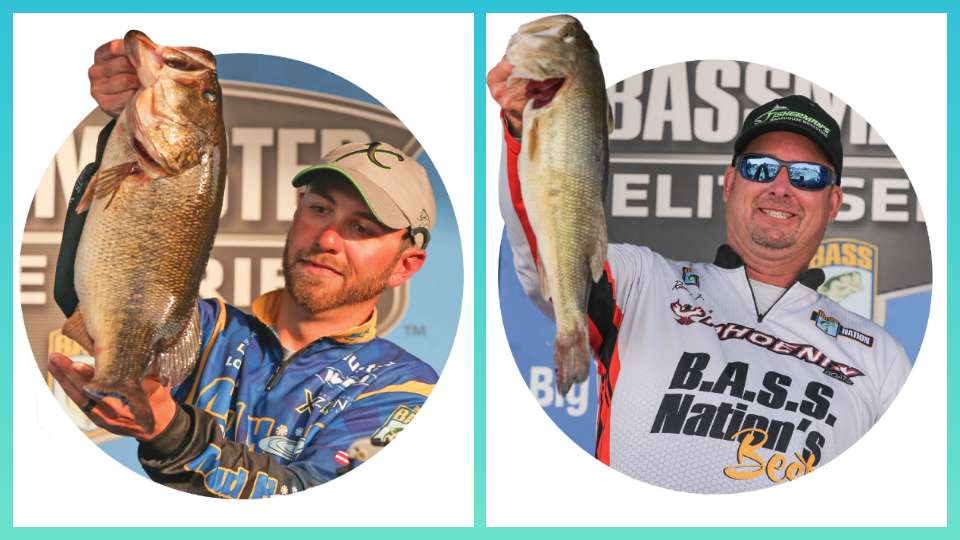
The New Year’s beginning brings big opportunities to tug on a big fish. It’s often the coldest time of the calendar, but the right tactics can unlock the hot bite. Check out what these Bassmaster Elite Series anglers have to say about engaging late-winter whoppers.
Editor’s note: Land of Giants Fall | Winter | Summer | Spring
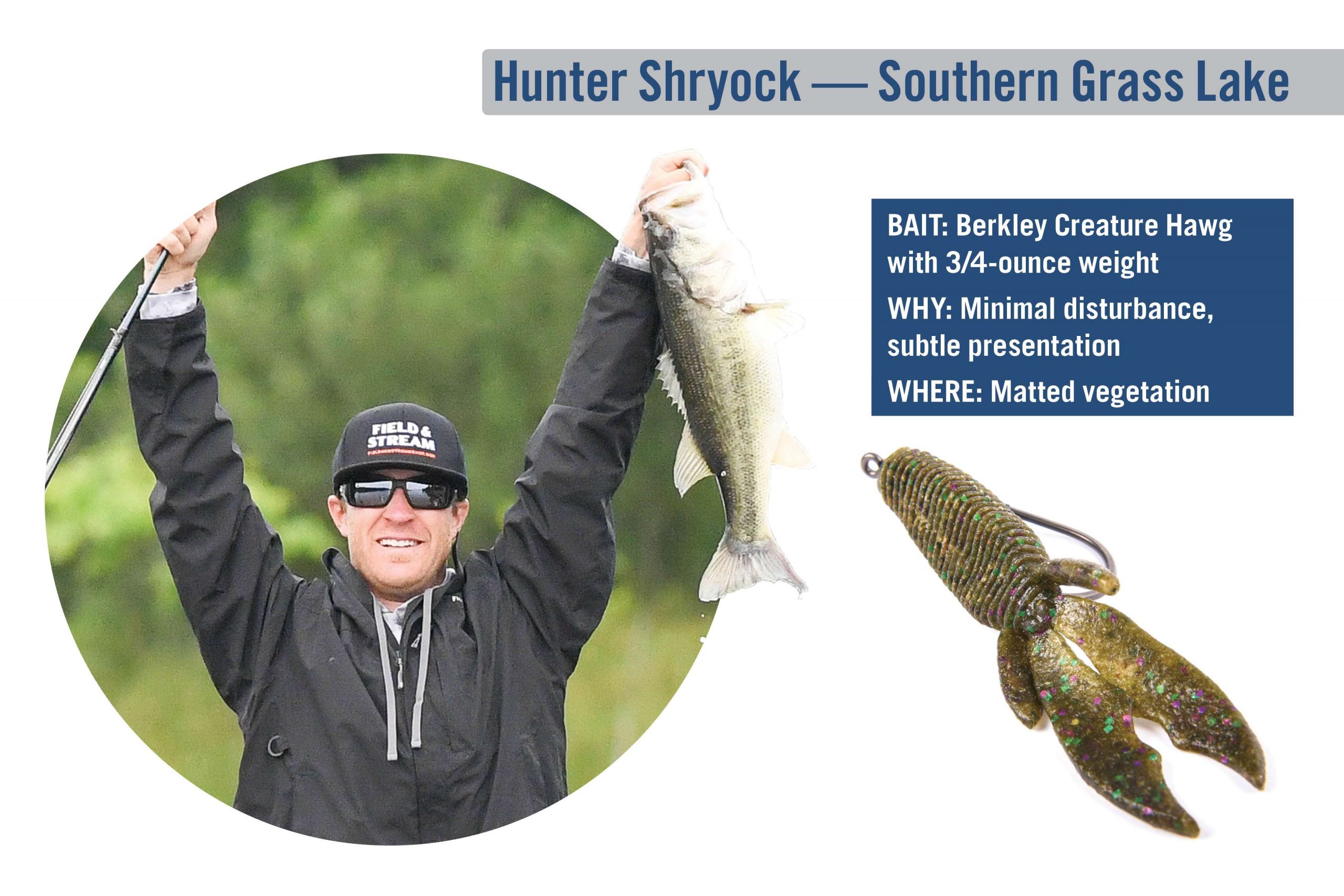
Hunter Shryock
Knowing that many of the fish live shallow, Shryock will identify major spawning flats and then dial in the sweetest-looking hydrilla mats where staging prespawners have likely positioned. Holding heat and providing ample feeding opportunities for bulging bass, these mats provide the ideal waiting room.
“In the wintertime, this is a huge deal, especially for those big prespawn fish,” Shryock said. “They like to get under those mats where the sun bakes on that vegetation and they can sit there and let their eggs develop.”
“When I start looking for mats, one of the first things I look for is how long the mat has been there. There are mats that generally blow around the lake — especially hyacinth mats — and you want mats that you feel have been there for a while. Maybe there’s hydrilla with a hyacinth mat blown in there. You know it’s been there a while because it’s really tall — that’s a money spot because there’s life underneath it, but more than likely, there’s a hole where that grass has died beneath. It’s almost like a dock.”
No surprise, punching is Shryock’s approach for bass holding in the thick cover, but he’s very particular in how he sets up his rig. These winter giants will eat, but subtlety is the key ingredient.
“With punching, everybody knows ‘big weights and big hook,’ but I try to get away with lighter weights and I tend to gravitate toward a 3/0 hook because I feel like I get a better hookup ratio using a 3/0 over a 4/0, depending on the size bait I’m using. If I’m using a Berkley Creature Hawg, I need a Berkley Fusion 19 straight-shank flipping hook, but a lot of times, I’ll use a Berkley Havoc Pit Boss Jr. or a 3-inch Chigger Craw and I can get away with that 3/0 hook.”
Shryock pairs his bait with the lightest weight he can get away with and still be able to penetrate the cover. “Light” may mean a 1 1/2-ounce weight, but it’s all relative, as the bottom line is minimizing the disturbance.
“An ounce and a half is better than a 2-ounce weight,” he said. “But, if I can get my bait through on an ounce and a quarter — even a 3/4 — on the initial flip, that’s the size weight I want.”
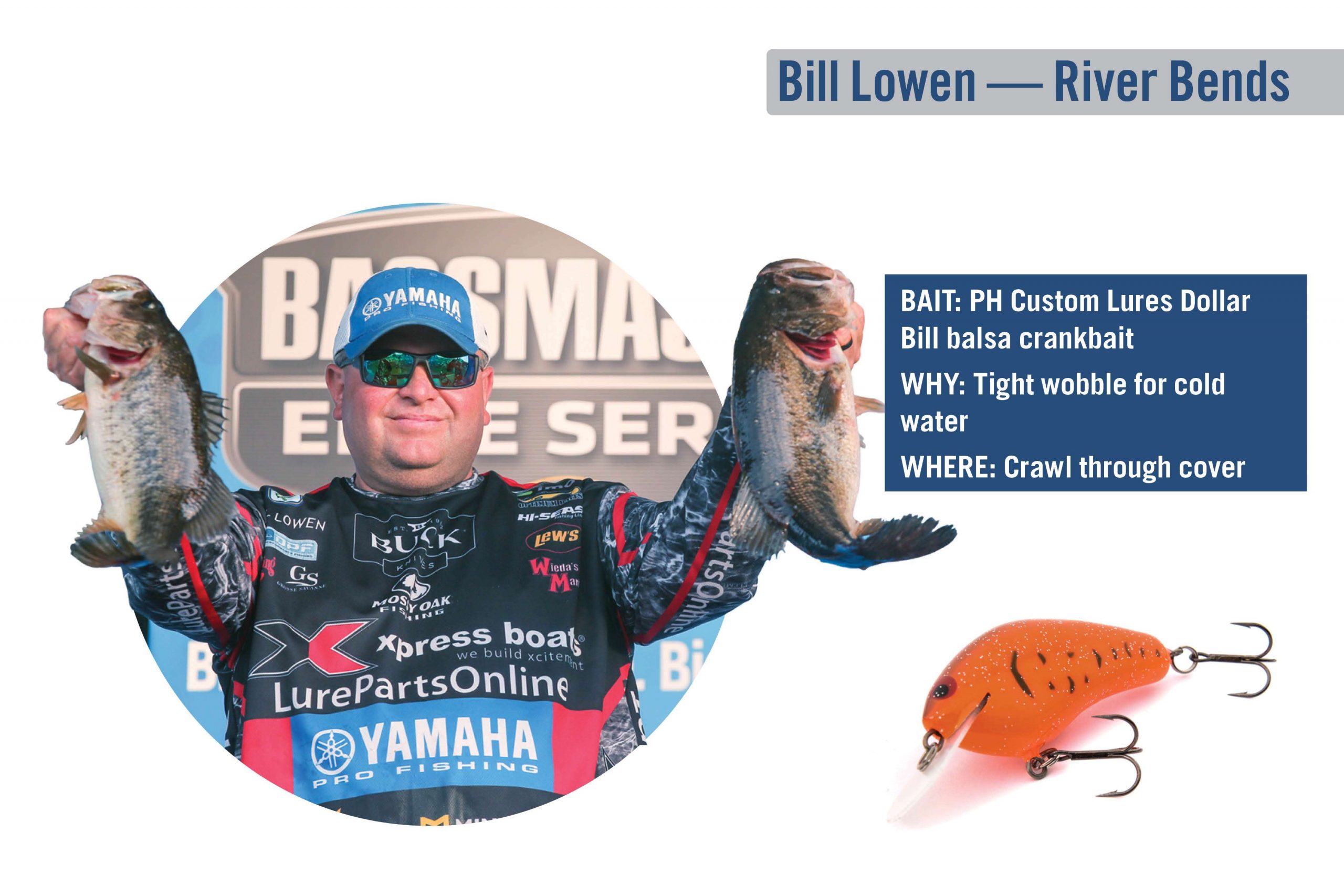
Bill Lowen
A channel swing bringing deep water close to a shallow area is Lowen’s ideal scenario for a winter river giant, and his bait of choice is a handmade PH Custom Lures Lowen’s Dollar Bill flat-sided balsa crankbait. Built to his specs, this bait puts on the kind of display bass like this time of year.
“A handmade balsa bait has what I call a tight wiggle or a tight wobble,” Lowen said. “I’m not a fan of a crankbait that has a lot of wiggle and a lot of thump in the early time of the year.
“I feel like crankbaits that have tighter wiggles do better in the cold water. It’s more natural because when the water’s cold, things aren’t extremely active.”
Lowen said he prefers bright colors, like chartreuse or orange, largely because of the water color he targets. He has no problem fishing clear conditions, but just the right amount of stain brings the fish into close reach.
“In the off-colored water, the fish tend to stay shallow,” he said. “I want just a little bit of color because dirty, cold water is the recipe for disaster.”
Maximizing the right deal requires tackle fit for the challenging task of accurately presenting a light lure. Lowen finds the parabolic design of a 7-foot Lew’s Custom Speed Stick Wart Special ideal for slinging the balsa crankbait.
“When you load up, the whole rod bends, from the handle to the tip,” he said. “When a fish eats the bait, the rod will ‘give’ it to the fish really good. The other benefit is castability. You always hear guys talking about how throwing a flat-sided bait is almost like throwing a potato chip. When that happens, they’re trying to force the cast; whereas, if you use the right rod, you just load up and let the rod make the cast for you.”
Also crucial is a Lew’s 5.1:1 BD1 reel with 12-pound Hi-Seas fluorocarbon. A glacially slow pace, he said, keeps the bait vulnerable, while the line choice keeps it pinned to the bottom.
“With that 12-pound line, I feel like I can keep that bait down there a lot better and a lot slower,” Lowen said. “That bait has some buoyancy, but with that 12-pound, there’s more material in that fluorocarbon and it helps me keep that bait down there.
“I want that bait to move as slowly as I can keep it and still keep bottom contact. I’m almost crawling it or worming it through the rock or laydowns or whatever I may fish.”
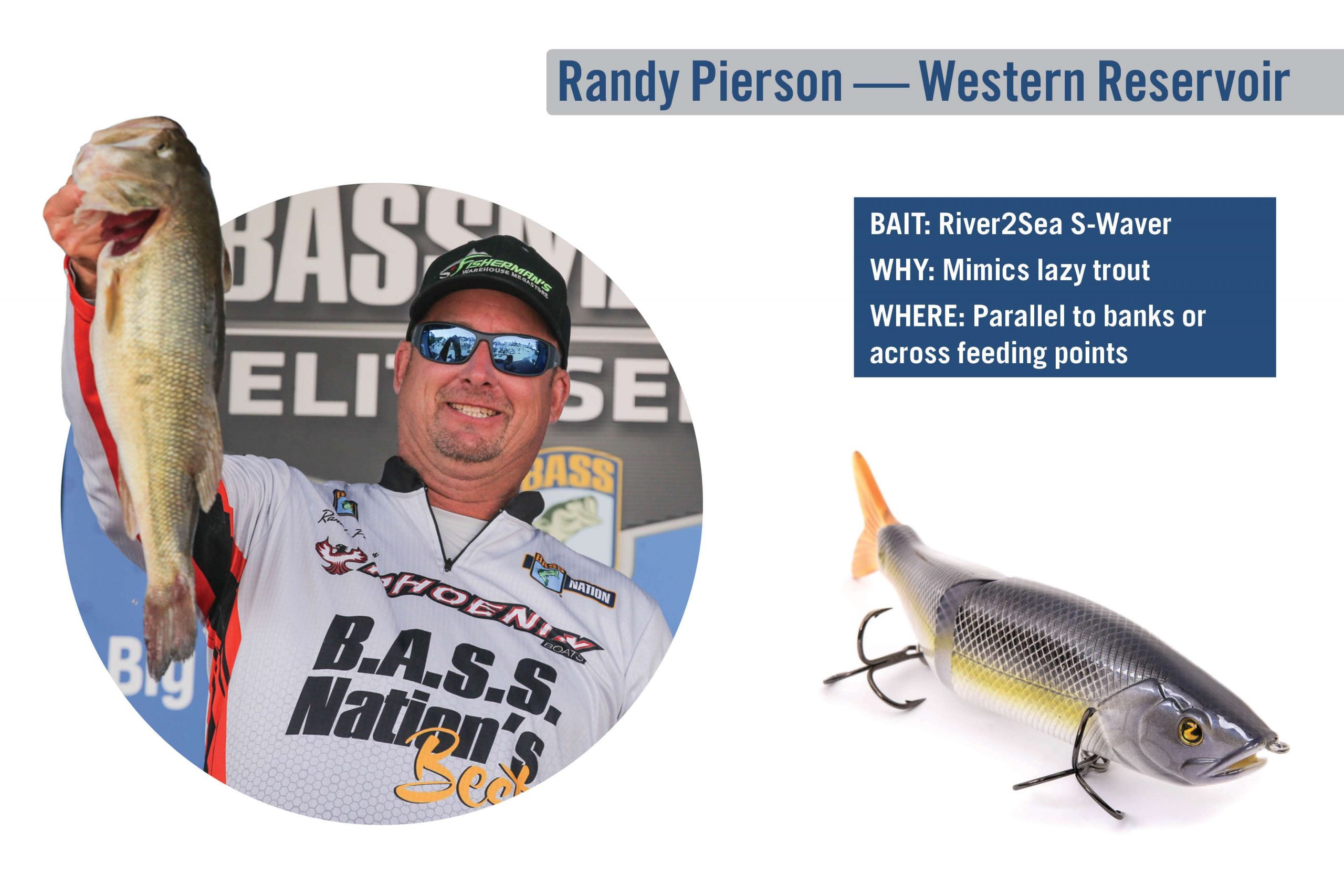
Randy Pierson
Calling January to February prime time for giant spotted bass in California’s deep, clear reservoirs, Pierson said he’ll begin his day by focusing on the long, shallow points where the heavyweights move up to feed. Quick access to deep water is essential, as the spots use the shallows to ambush traveling rainbow trout and Kokanee (landlocked sockeye salmon) in the early hours and then slide out to suspend during sunny periods.
“If you’re able to find a tree stump, that’s a lot better,” Pierson said. “If the lakes are lower, you can find that, but if they’re higher, you’re not going to really find that much wood structure. But some kind of rock will work. Any kind of structure is good, but it’s not a necessity — a flat with deep water close to it is a necessity.
“I don’t look for any [forage], but the trout and Kokanee have to come around them at some time. I think that’s why the points that stick out — even an island hump — those are the better areas to look for. Those trout and Kokanee don’t often run next to the bank, but when they’re cruising around a little deeper, those bass hanging around a shallow point can run out and grab the [forage].”
During the first hour of the day, when big spots move supershallow, Pierson tempts them with a trio of baits, starting with a Texas-rigged 6-inch trick worm. He likes watermelon candy, watermelon red or watermelon purple for clear water, while green pumpkin works better if rain runoff darkens the water.
Pierson also relies on a River2Sea S-Waver — a glide bait that produced his personal best 10-1 in 2013 — and a Neko-rigged Senko. Presentation strategy matters, he said.
“I crawl the Texas-rigged worm slowly on the bottom,” Pierson said. “I know some people throw jigs, but a lot of times, if there are big enough rocks, a jig will get snagged up.
“With the S-Waver, I’ll cast it up next to the bank and use a slow retrieve, and to change it up, I’ll cast across a point, let it slowly sink to the bottom and just slow roll it back. During the retrieve, I’ll stop it and twitch to make the bait turn around, and that often triggers strikes.”
Describing the big spots’ seasonal mood, Pierson said, “Early in the morning, they’re fairly aggressive; you don’t have to do much. They’re up there shallow to feed.”
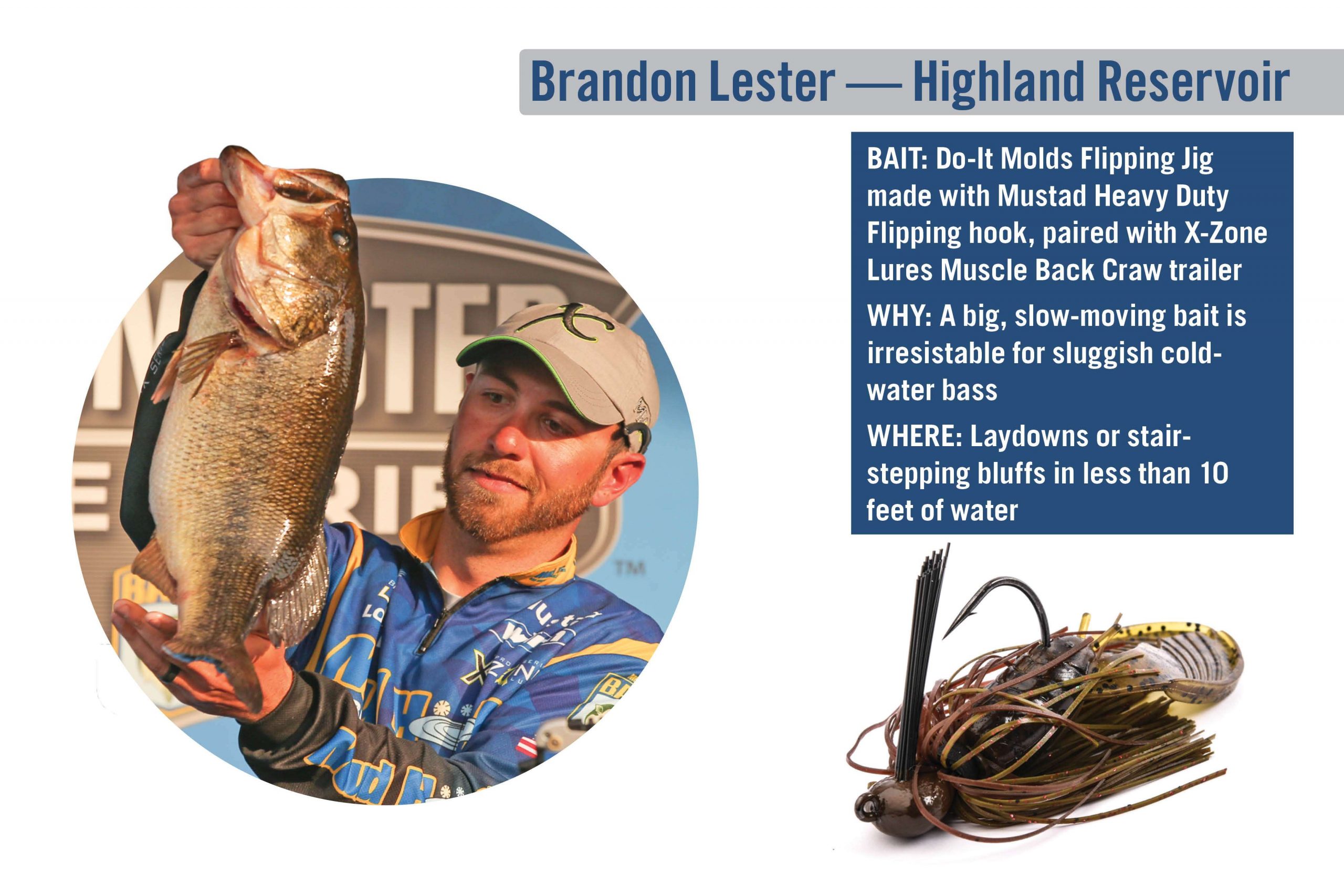
Brandon Lester
Anytime the water’s cold, Lester’s confident that a jig’s prominent profile and bottom-hugging ability will earn him his biggest bites. Favoring a homemade Do-It Molds flipping jig, Lester ensures his bait can stand up to the true giants by incorporating a stout 4/0 to 5/0 Mustad Heavy Duty flipping hook.
“I like the Arkie-style head in 3/8 and 1/2 ounce,” he said. “Most of the time, I lean toward 1/2 ounce, but sometimes, when it’s cold, 3/8 will get you more bites.”
Lester keeps his color selection simple with black/blue for dirty water and brown or green pumpkin/orange for clear water. His go-to trailer is a color-matching X-Zone Lures Muscle Back Craw modified for the task.
“It’s a 4-inch bait, but I cut it in half and thread it up on the jig,” Lester said. “The pincers don’t have salt, so they stand up like a crawfish. They have a sluggish action, and that’s what you want in the cold water.”
This slow, buoyant appearance plays well with Lester’s winter giant game plan. Mostly targeting laydowns or stair-stepping bluffs, he knows this time of year demands a prudent mix of patience and anticipation.
“The water may be down into the lower 50s, maybe even the 40s, so keep in mind that those fish are pretty sluggish,” Lester notes. “I tend to work my jig fairly slow. I pitch it in there, make sure it gets to the bottom, pick it up and let it go back to the bottom a couple of times.
“Most of the time, I’m fishing more vertical stuff, so I’m flipping it up there, working it down that stair bank, and once it gets down there to about 10 feet, I’ll reel it in and make another flip.”
Lester’s hard-and-fast rule: Never flip, even winter fish, with anything less than 20-pound fluorocarbon.
“I want to have the confidence that if I hook him, he’s coming in the boat,” he said. “And watch your line. They tend to bite it on the fall, and a lot of times, you’ll just see your line jump. Especially this time of year, they don’t just [crush] it like they do in the summer.”
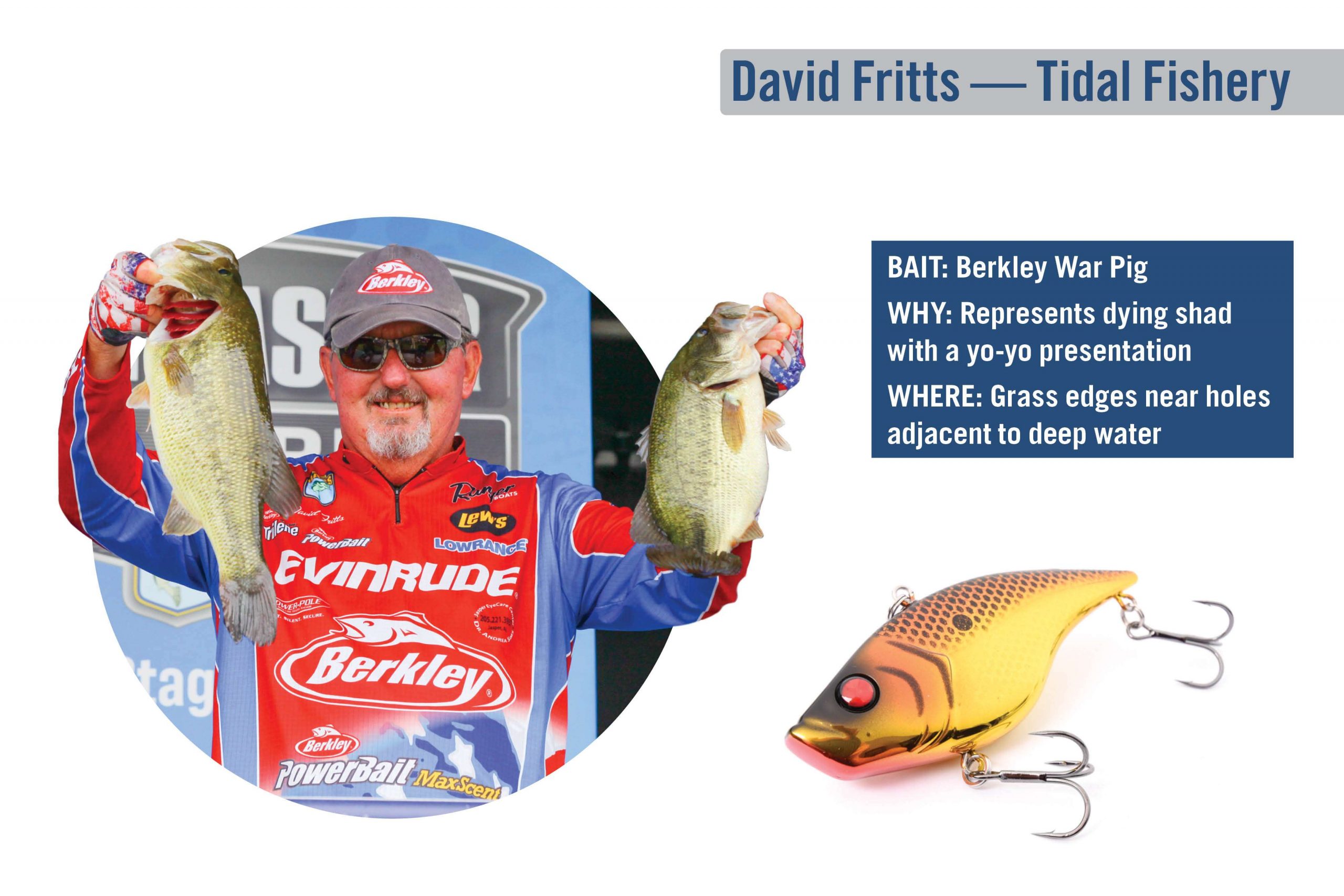
David Fritts
Although wood cover and rocky current breaks get most of the attention of tidal waters such as the James River, Fritts said he has found that the biggest fish often live in totally slack-water areas like a natural hole or a dugout that’s out of the main river current. Older and wiser, these hefty fish have learned the value of efficient lifestyles.
“I think the biggest reason they like these spots is they’re not exerting as much energy,” Fritts said. “A bass can avoid the current during slack tide, but 80 percent of the time, they have to keep moving to fight the current.
“Those holes are always adjacent to deep water, so they can move up and down to feed. It’s always good to have grass, because it keeps the forage in there, but most of the time those big fish will be in front of the grass on some type of cover.”
Noting that these spots are less visible and therefore less pressured, Fritts said he consistently fares best with a falling presentation. Tops for him is yo-yoing a 1/2- to 3/4-ounce Berkley War Pig lipless crankbait.
“I’ll throw it up next to the grass, let it fall, lift it up and let it fall,” Fritts said of the taunting tactic. “You can also hold your rod at 10 to 11 o’clock, wind up five or six times really fast and then let it fall.
“That War Pig is actually made to do this because of the action it has when it falls. It sort of wants to dart around like a dying shad.”
Fritts’ second option for this scenario would be a 5/8-ounce jig in black and blue — maybe a touch of orange or chartreuse, based on seasonal crawfish coloration. A Berkley Chigger Craw or Fatty Craw fills the trailer job nicely, but Fritts likes a particular preparation.
“I like to trim my jig skirt and shorten my trailer so I have about 3/4 of the claws showing,” he said. “It’s really compact, and I’ve done a lot better with big fish with this [preparation].”
Originally appeared in Bassmaster Magazine 2020.





